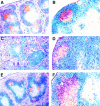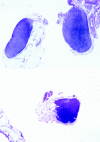A role for tumor necrosis factor receptor type 1 in gut-associated lymphoid tissue development: genetic evidence of synergism with lymphotoxin beta
- PMID: 9625757
- PMCID: PMC2212356
- DOI: 10.1084/jem.187.12.1977
A role for tumor necrosis factor receptor type 1 in gut-associated lymphoid tissue development: genetic evidence of synergism with lymphotoxin beta
Abstract
Lymphotoxin alpha (LTalpha) signals via tumor necrosis factor receptors (TNFRs) as a homotrimer and via lymphotoxin beta receptor (LTbetaR) as a heterotrimeric LTalpha1beta2 complex. LTalpha-deficient mice lack all lymph nodes (LNs) and Peyer's patches (PPs), and yet LTbeta-deficient mice and TNFR-deficient mice have cervical and mesenteric LN. We now show that mice made deficient in both LTbeta and TNFR type 1 (TNFR1) lack all LNs, revealing redundancy or synergism between TNFR1 and LTbeta, acting presumably via LTbetaR. A complete lack of only PPs in mice heterozygous for both ltalpha and ltbeta, but not ltalpha or ltbeta alone, suggests a similar two-ligand phenomenon in PP development and may explain the incomplete lack of PPs seen in tnfr1-/- mice.
Figures


Similar articles
-
Mesenteric lymph nodes are critical for the induction of high-dose oral tolerance in the absence of Peyer's patches.Eur J Immunol. 2002 Apr;32(4):1109-13. doi: 10.1002/1521-4141(200204)32:4<1109::AID-IMMU1109>3.0.CO;2-K. Eur J Immunol. 2002. PMID: 11920578
-
Intestinal cryptopatch formation in mice requires lymphotoxin alpha and the lymphotoxin beta receptor.J Immunol. 2004 Dec 15;173(12):7183-9. doi: 10.4049/jimmunol.173.12.7183. J Immunol. 2004. PMID: 15585839
-
Peyer's patch organogenesis is intact yet formation of B lymphocyte follicles is defective in peripheral lymphoid organs of mice deficient for tumor necrosis factor and its 55-kDa receptor.Proc Natl Acad Sci U S A. 1997 Jun 10;94(12):6319-23. doi: 10.1073/pnas.94.12.6319. Proc Natl Acad Sci U S A. 1997. PMID: 9177215 Free PMC article.
-
The lymphotoxin pathway: beyond lymph node development.Immunol Res. 2006;35(1-2):41-54. doi: 10.1385/IR:35:1:41. Immunol Res. 2006. PMID: 17003508 Review.
-
Lymphotoxin-alpha-deficient and TNF receptor-I-deficient mice define developmental and functional characteristics of germinal centers.Immunol Rev. 1997 Apr;156:137-44. doi: 10.1111/j.1600-065x.1997.tb00965.x. Immunol Rev. 1997. PMID: 9176705 Review.
Cited by
-
The intriguing biology of the tumour necrosis factor/tumour necrosis factor receptor superfamily: players, rules and the games.Immunology. 2005 May;115(1):1-20. doi: 10.1111/j.1365-2567.2005.02143.x. Immunology. 2005. PMID: 15819693 Free PMC article. Review.
-
DR3 regulates negative selection during thymocyte development.Mol Cell Biol. 2001 May;21(10):3451-61. doi: 10.1128/MCB.21.10.3451-3461.2001. Mol Cell Biol. 2001. PMID: 11313471 Free PMC article.
-
Bacterial particle endocytosis by epithelial cells is selective and enhanced by tumor necrosis factor receptor ligands.Clin Vaccine Immunol. 2009 Mar;16(3):397-407. doi: 10.1128/CVI.00210-08. Epub 2009 Jan 7. Clin Vaccine Immunol. 2009. PMID: 19129472 Free PMC article.
-
Influence of the Draining Lymph Nodes and Organized Lymphoid Tissue Microarchitecture on Susceptibility to Intradermal Trypanosoma brucei Infection.Front Immunol. 2020 Jun 3;11:1118. doi: 10.3389/fimmu.2020.01118. eCollection 2020. Front Immunol. 2020. PMID: 32582198 Free PMC article.
-
Lymph node germinal centers form in the absence of follicular dendritic cell networks.J Exp Med. 1999 Mar 1;189(5):855-64. doi: 10.1084/jem.189.5.855. J Exp Med. 1999. PMID: 10049949 Free PMC article.
References
-
- Roberts CW, Shutter JR, Korsmeyer SJ. Hox11controls the genesis of the spleen. Nature. 1994;368:747–749. - PubMed
-
- Miyawaki S, Nakamura Y, Suzuka H, Koba M, Yasumizu R, Ikehara S, Shibata Y. A new mutation, aly, that induces a generalized lack of lymph nodes accompanied by immunodeficiency in mice. Eur J Immunol. 1994;24:429–434. - PubMed
-
- Shinkura R, Matsuda F, Sakiyama T, Tsubata T, Hiai H, Paumen M, Miyawaki S, Honjo T. Defects of somatic hypermutation and class switching in alymphoplasia (aly)mutant mice. Int Immunol. 1996;8:1067–1075. - PubMed
Publication types
MeSH terms
Substances
LinkOut - more resources
Full Text Sources
Molecular Biology Databases
Miscellaneous

